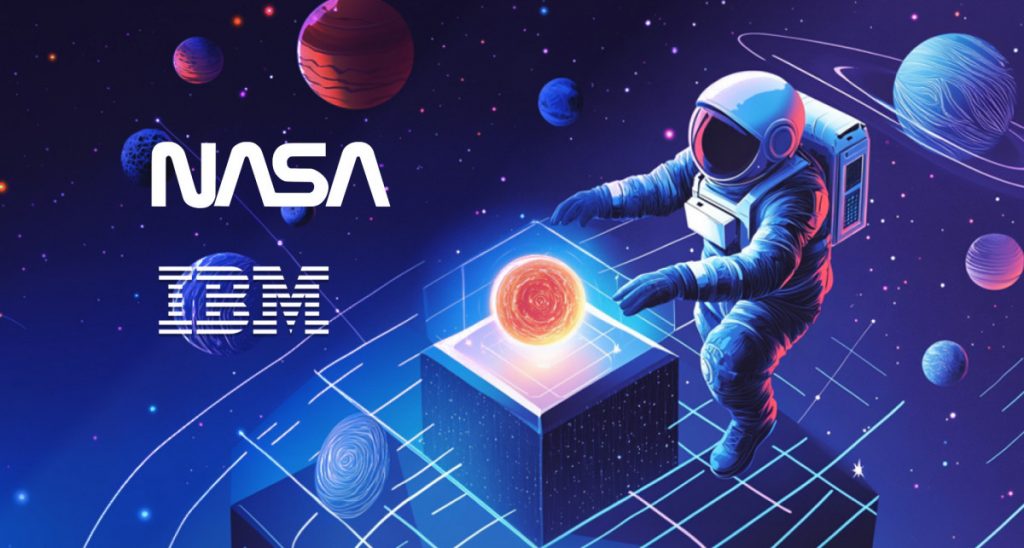IBM And NASA Open Source Surya AI To Accelerate Prediction Of Hazardous Solar Storms


In Brief
IBM Research and NASA have launched Surya, an open-source AI that predicts solar flares faster and 16% more accurately using nine years of high-resolution SDO imagery.

IBM Research, the research and development division of technology company IBM, announced that it has partnered with NASA to open source Surya, a new AI model for solar physics designed to predict intense solar outbursts that could pose risks to astronauts, satellites, power grids, and communications on Earth, with unprecedented speed.
For the past 15 years, NASA’s Solar Dynamics Observatory (SDO) satellite has continuously monitored the Sun to improve understanding of solar activity, yet much of the data it has collected remains unexplored. When the SDO launched, artificial intelligence tools were still in their early stages, limiting the ability to fully analyze the continuous stream of imagery.
Surya, described as the first foundation model for solar physics, addresses this gap. By processing raw data from the SDO, researchers from IBM, NASA, and eight additional research centers have developed an AI model capable of forecasting dangerous solar events that can affect both space and Earth-based systems.
Named after the Sanskrit word for “Sun,” Surya is now publicly available on Hugging Face, GitHub, and through IBM’s TerraTorch library for fine-tuning geospatial AI models. Alongside Surya, the team has released SuryaBench, a set of curated datasets and benchmarks designed to facilitate the development and evaluation of applications not only for space weather prediction but also for broader solar research.
Forecasting severe storms on Earth is already challenging, and predicting solar storms adds additional complexity. Solar flares erupt through the Sun’s magnetic field, and the light from these events takes approximately eight minutes to reach Earth. This delay underscores the need for predictive models that can provide early warnings of solar activity before it impacts astronauts, satellites, and infrastructure on the planet.
Surya AI Advances Heliosphere Forecasting With Enhanced Solar Flare Prediction And Magnetic Mapping
IBM’s Surya initiative reflects a larger strategy to adopt generative and automated methods that allow algorithms to be developed, tested, and refined at scale. The project illustrates IBM’s perspective on AI as not only a tool but also a contributor and driver of scientific exploration.
The Solar Dynamics Observatory (SDO) maintains an orbit alongside Earth to provide a consistent view of the Sun, capturing images every 12 seconds across multiple wavelength bands. These images reveal temperature variations across the Sun’s layers, ranging from approximately 5,500°C at the surface to nearly 2 million °C in the corona, the outermost part of its atmosphere. In addition, the SDO maps the Sun’s magnetic activity, capturing emerging sunspots in white light, measuring the speed of plasma bubbles at the surface, and tracking the twisting and tangling of magnetic field lines.
To train Surya, researchers used nine years of SDO data, first harmonizing the various data types and then experimenting with AI architectures to process the information. The final model uses a long-short vision transformer with a spectral gating mechanism, allowing it to handle SDO’s high-resolution 4096 x 4096-pixel images, which contain up to ten times more detail than typical image data. The spectral gating also reduced memory usage by around 5% and helped filter noise from the dataset.
In contrast to previous work with Prithvi, where models reconstructed partially obscured Earth satellite images, Surya was trained to predict what the SDO would observe an hour into the future based on sequential images. Predictions were then compared with actual observations to measure accuracy. By requiring the model to infer essential elements such as solar geometry, magnetic structure, and differential rotation, the researchers aimed to prepare Surya for a variety of scientific applications. Initially, the team attempted to explicitly encode the Sun’s faster rotation at the equator compared to its poles, but allowing the model to learn this behavior from data proved more effective, resulting in better performance.
Surya demonstrated strong forecasting capabilities, including solar flare prediction. Current methods allow scientists to anticipate flares an hour in advance, while Surya achieved a two-hour lead time using visual data. Early tests also indicated a 16% improvement in solar flare classification accuracy, representing a significant advancement over existing techniques and potentially making Surya the first model capable of providing this level of early warning.
Surya And SuryaBench Enable AI-Powered Forecasting Of Solar Activity And Space Weather Impacts
Surya and SuryaBench are designed to make AI-driven solar research accessible to scientists without deep expertise in artificial intelligence. SuryaBench provides curated datasets and benchmarks for key space weather prediction tasks, including forecasting solar flares, predicting solar wind speeds, and analyzing the magnetic structure of the Sun’s corona. The tools also tackle long-standing questions, such as why solar winds intensify during the Sun’s quieter phases.
The datasets focus on the Sun’s active regions, dark spots on its surface where magnetic energy builds and eruptions like solar flares and coronal mass ejections originate. These events can interact with Earth’s magnetic field, disrupting satellites, communications, and power systems. By training AI models on these data, Surya enables predictions of solar activity hours in advance, improving early warning capabilities for space weather hazards.
SuryaBench includes applications for detecting extreme ultraviolet radiation and monitoring magnetic line accumulation in the Sun’s atmosphere, which can accelerate solar wind to potentially damaging speeds. By integrating this information, scientists can better anticipate the impact of solar activity on Earth, including effects on satellites, power grids, and communications infrastructure.
Together, Surya and SuryaBench provide a new AI-driven framework for understanding and predicting solar phenomena, offering faster, more accurate forecasting of potentially hazardous solar events and giving researchers tools to respond proactively to space weather threats.
Disclaimer
In line with the Trust Project guidelines, please note that the information provided on this page is not intended to be and should not be interpreted as legal, tax, investment, financial, or any other form of advice. It is important to only invest what you can afford to lose and to seek independent financial advice if you have any doubts. For further information, we suggest referring to the terms and conditions as well as the help and support pages provided by the issuer or advertiser. MetaversePost is committed to accurate, unbiased reporting, but market conditions are subject to change without notice.
About The Author
Alisa, a dedicated journalist at the MPost, specializes in cryptocurrency, zero-knowledge proofs, investments, and the expansive realm of Web3. With a keen eye for emerging trends and technologies, she delivers comprehensive coverage to inform and engage readers in the ever-evolving landscape of digital finance.
More articles

Alisa, a dedicated journalist at the MPost, specializes in cryptocurrency, zero-knowledge proofs, investments, and the expansive realm of Web3. With a keen eye for emerging trends and technologies, she delivers comprehensive coverage to inform and engage readers in the ever-evolving landscape of digital finance.


















































